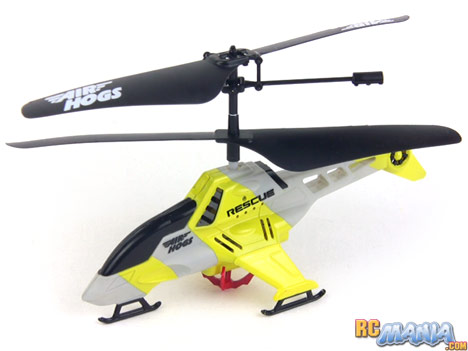Air Hogs Fly Crane

Street Price: $39.99 US
Manufacturer: Spinmaster
Mfgr's recommended min. age: 10
Our recommended age range: 10+
Primary use: Indoors
Top speed: n/a
Radio:n/a, infraread
Includes:
- RC helicopter
- Controller
- Instructions
- 3x "rescue basket" cargo
- 6x AA batteries
Initial Impressions
The Air Hogs Fly Crane is the latest RC micro helicopter innovation from Spin Master and it offers a little something extra and unexpected. The basic design is of a coaxial heli -- two sets of main rotor blades that spin in opposite directions, with no tail rotor. The fuselage is very modern, if not slightly futuristic, and it's made of plastic, not foam, with nice details and three landing skids to make it stable on on the ground. The little red thing that looks like an anchor, which you see in the picture above, is what makes the Fly Crane interesting. It's a 4-sided grappling hook attached to a sturdy string that can be remotely let out and wound back up! The idea is that you can actually pick things up, and they include three lightweight plastic rescue baskets for you to practice with.
The battery in the Fly Crane itself is rechargable, but not removable. A charging cord built into a compartment on the front of the controller plugs right into the heli and will fill up a depleted battery in roughly 30 minutes.
Testing
After lowering & raising the hook on the Fly Crane a few times just to marvel at how cool it looks, I started flying the craft around as just a normal, plain micro indoor helicopter. In this capacity, it's great. It requires some yaw (right/left turning) trimming on the controller when it first takes off, but it's very stable and controllable after that. It functions as a 2-channel heli, so you only have up/down and left/right control. The Fly Crane is designed to always move forward on its own, so you just regulate your altitude and steer it where you want to go. As the battery charge slowly depletes, I had to re-adjust the turning trim a handful of times, but this is actually common with coaxial helicopters, even the much more expensive hobby-grade ones. A single battery charge would last for about 6 to 7 minutes of actual flying time.
Next I was happy to try out the "crane" feature of the Air Hogs Fly Crane. I set up the three little rescue baskets and lowered the heli's hook to get some practice in. It didn't take long for me to realize that picking things up is very difficult, especially if conditions aren't absolutely perfect and you're not running in a wide open area with the targets on a smooth floor. The grappling hook may not weigh much, but when it swings around it does pull on the heli a bit and affect its movement. If you get a little low and drag it on the ground, it does even more, angling the Fly Crane forward which causes it to increase its forward speed and require even more throttle than normal to rise up in the air again (which, in turn, makes it go still faster because of the lean). Once I did successfully hook a basket, things got even more hairy as the Fly Crane requires probably 80% of maximum throttle just to maintain its height in the air. If I was more than halfway through the battery charge, I had to go almost full throttle to keep from just falling down to the ground and dragging the basket around like an airborne tow truck. A couple minutes before the battery runs out, the heli is no longer even able to lift an empty basket. Over the course of 5 full battery charges of attempts, I managed to successfully hook a basket an average of just one time per charge, and most of those times I wasn't able to keep it in the air -- it just crashed from not having enough power or control. On my sixth flight, I tried keeping the hook retracted until I thought I had a good line-up on a basket. This helped with control in advance. Retracting the hook after catching a basket also helps reduce the effect that the swinging basket has on flight. However, I noticed that when raising the hook, with or without a basket, the Fly Crane would get a short burst of forward speed, so again it appeared that a very large area flying space was really needed.
Eventually I questioned how much "cargo" the Air Hogs Fly Crane could lift in one of the baskets, and the answer was not much at all. Two to three small LEGO bricks, for instance, had it straining for dear life to stay off the ground, even at full throttle, with a fresh charge.
Videos
(Click a video a second time to view it larger in a new window.)
Conclusion
As a small, indoor RC helicopter, the Air Hogs Fly Crane is great. It's simple & easy to fly, durable, and great-looking. Its size is a little larger than what's typical for micro helis, and with the nice design and bright colors it makes a very nice visual impact whether it's in flight or on land. What makes it different & special, though, is the retractable hook system, and unfortunately that just doesn't so work well in my experience. That defeats much of the point of spending extra for it, and I practically have to rate the whole thing as just a very, very nice, small, 2-channel heli, that costs a somewhat steep $40 US.





